This blog contains all kinds of avatarfacts. Feel free to submit facts, or ask something. Also visit my mainblog: PortkeytoNarnia.tumblr.com
Don't wanna be here? Send us removal request.
Photo








First look at Avatar The Last Airbender: Legacy of the Fire Nation!
Hot on the heels of the AMAZING The Legend of Korra: An Avatar’s Chronicle comes the next Avatar offering from Insight Editions, who have provided me with the cover and our first previews of the new book!
Legacy of the Fire Nation features letter collected from Iroh to Zuko, during the peace after the Hundred Year War.
Notably, it features our first canon look at the Gaang in their twenties as they start a new generation!
As you can see from the preview images, the book is fully illustrated and includes never-before-seen scenes from after the war including what looks like:
Iroh visiting Katara (in the Southern Water Tribe?) while Bumi and Kya play!
Aang and Zuko at some kind of opening event in the early days of Republic City. (Very reminiscent of the statue Zuko would later have in the city.)
On top of that, we have Iroh’s never-before-seen royal portrait, and who knows what else is going to be included in the full book, which is going to be 64 fully-illustrated pages in hardcover!
This is honestly pretty amazing and unexpected, but we shouldn’t be surprised at this point based on, again, how good An Avatar’s Chronicle is.
Avatar at NYCC 2019
Insight Editions is going to be at this year’s New York Comic Con (October 3rd to 6th) at booth #1946. They’re going to have An Avatar’s Chronicle for sale (you NEED to check it out), which will come with this amazing convention exclusive poster.
There will also be the official panel on Saturday in room 1A21 - Javits Center, featuring The Rise of Kyoshi author F. C. Yee.
AND there’s an exclusive NYCC Funko Pop of, wait for it, the cabbage merchant! Yeah baby.
Legacy of the Fire Nation hits shelves on February 4th, 2020!
5K notes
·
View notes
Photo
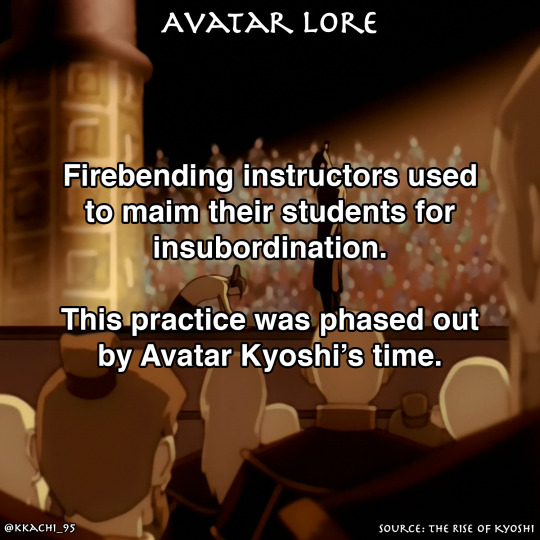




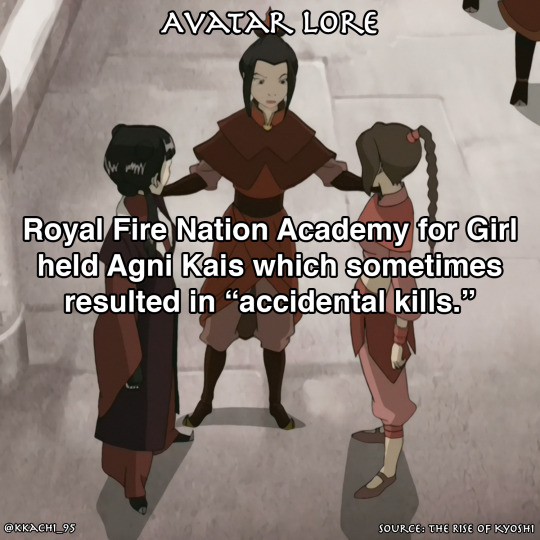


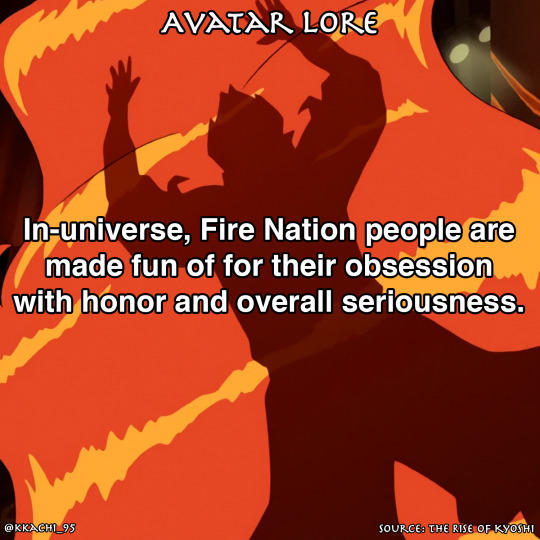

Avatar Lore from The Rise of Kyoshi - Part 1
30K notes
·
View notes
Photo
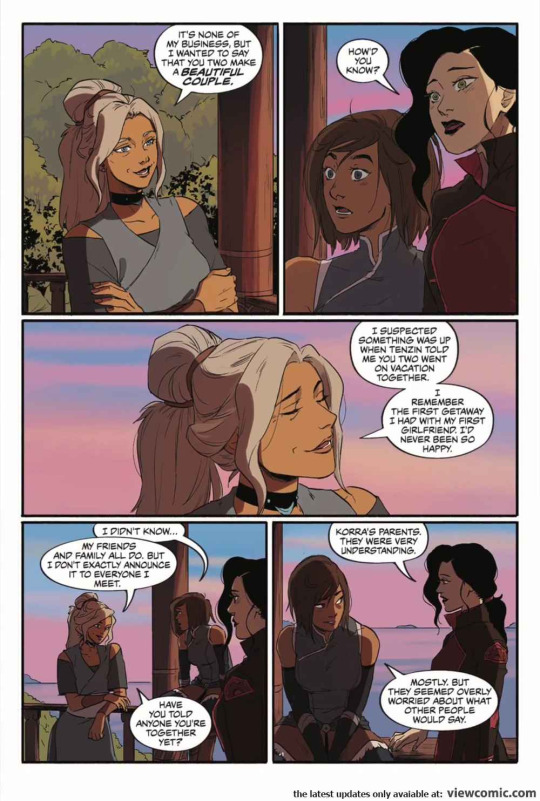
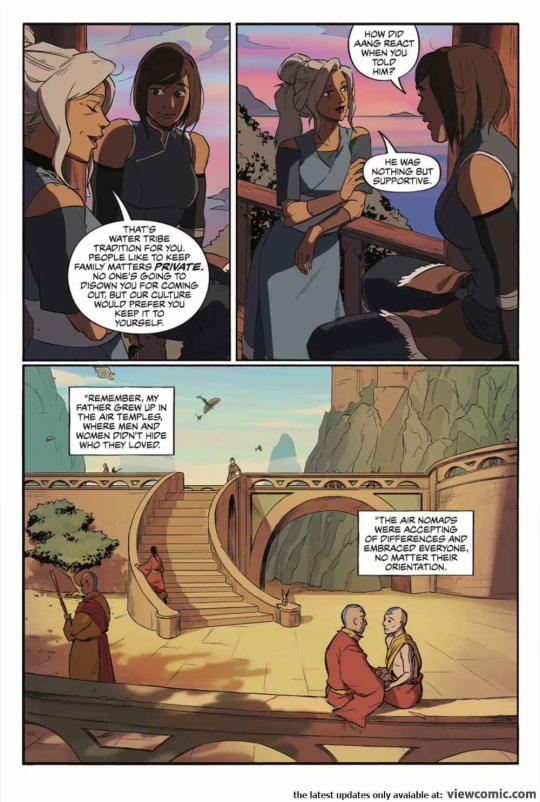
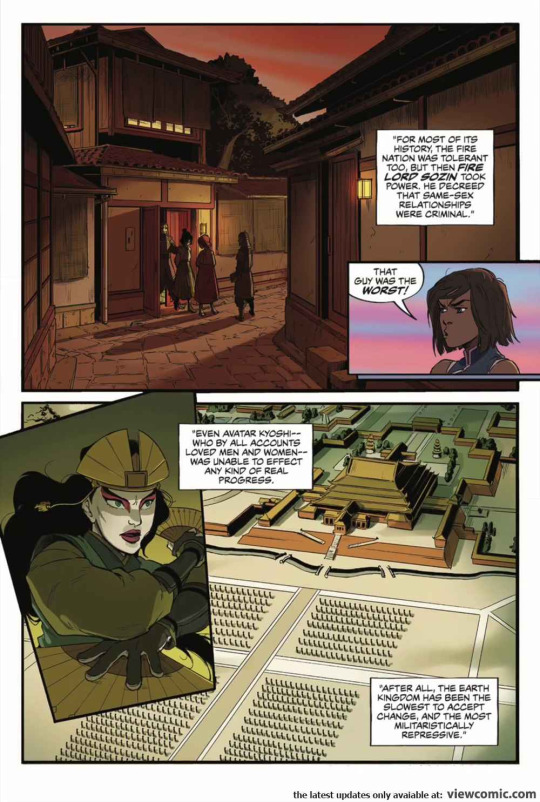
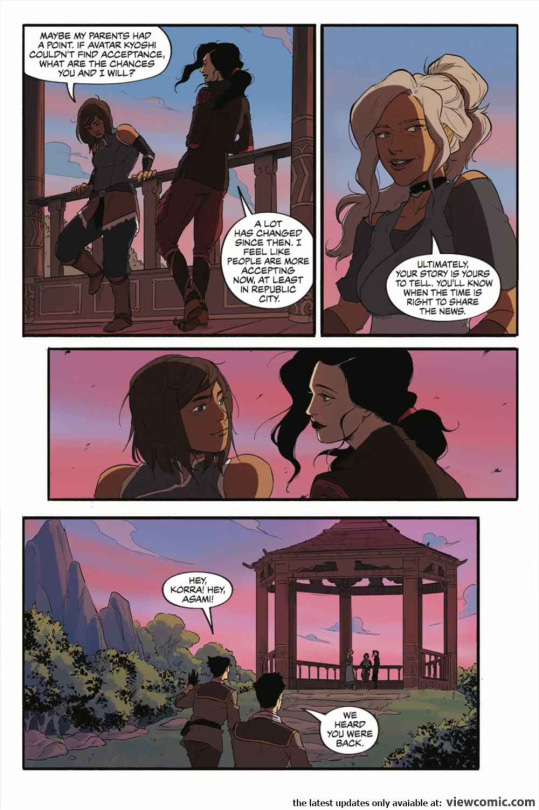
Kya, canonically a lesbian, tells Korra and Asami about same-sex relationships and coming out in the four nations. We also find out that Kyoshi was bi!
144K notes
·
View notes
Photo



Legend of Korra fans, you can FINALLY see what happens next to Korra and Asami, thanks to Dark Horse’s new comic sequel, The Legend of Korra: Turf Wars. See the full preview here.
40K notes
·
View notes
Link
[ew_brightcove videoid="5157200895001" pushTop autoPlay] The Legend of Korra wrapped up back in 2014, but that doesn't mean the end of the line for Korra, Asami, and the other heroes of Republic City.
6 notes
·
View notes
Photo




I also plan on drawing Mai and Aang! Thank you requesting Katara, she is a favorite <3
3K notes
·
View notes
Text
The Avatars and Their Favored Styles in The Avatar State
I have this new theory that the Avatars experience their “natural style” of using the Avatar State based on their native element…or based on their favored element! So like wait… LOOK AT HOW BOTH AANG AND YANGCHEN USE THE AVATAR STATE THOUGH


They’re the only two Avatars that we have seen attain this kind of sustained flight in the Avatar State. They surround themselves with all four elements to use at their disposal. When you think about it, Air is the most important here too. They can fly in any direction for as long as they want, since the spiraling sphere of Air they’ve contained themselves in allows for that kind of mobility.
I’m not saying they’re the only two Avatars that could use this technique, but they are the only two that have, and I don’t think them being the only two Air Avatars we’ve seen in action using the Avatar State is coincidental. Also, think about it…
After Aang has mastered the Avatar State, it’s the only “all powerful” Avatar State form that he’ll use!

I really do think it means something that when Aang goes full-on Kyoshi and splits Yu Dao from its immediate surroundings in The Promise, Part 3, he’s in the ultimate Air ball again! It’s definitely his preferred form for the Avatar State, and the free-flight mobility and all-encompasing protection the form provides by shrouding the Avatar in Air strikes me as deeply ingrained in Airbending, both Aang’s native and favored element.
Also like think about it. The only Earth Avatar we’ve seen in the Avatar state stayed COMPLETELY ROOTED TO THE EARTH, unleashing massive blasts on her opponent also while, you know, separating her entire island from the mainland continent. Like I said, full-on Kyoshi.



Rather than flit about, protecting herself and giving herself access to the greatest mobility the Avatar can achieve in the Air ball, she stands her ground knowing no one can compete with her power while in the Avatar State. This is the Earthbender’s gambit and it suits her well.
Now Korra, as opposed to Aang or Yangchen or even Kysohi, strikes me as either Water or Fire in terms of her favored forms for the Avatar State, and this makes sense given her native element of Water and her favored element of Fire.
I hold that, unlike Air Avatars who fly comletely free from the ground in an Air sphere, Water Avatars prefer the more connected and stabalized form of flight: the Water or Air Spout.
And how do we see Korra take flight the very first time she enters the Avatar State?
That’s right. On a spout!

Keep reading
3K notes
·
View notes
Photo





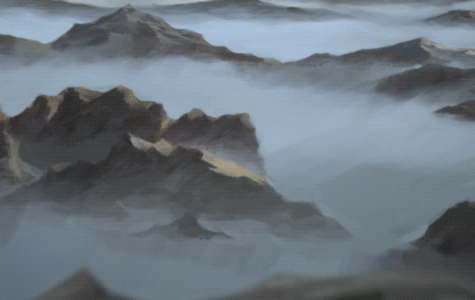
Aang/Zaheer: Flight and The Thought Chakra
Someone said to me, “Even Aang couldn’t fly like that.” Then I recalled the moment he relinquished his connection to Katara, unlocked the Thought Chakra, and entered the Avatar State under the influence of pure cosmic energy. Aglow with heavenly light, he levitated. We see no evidence of Airbending; he merely floats skyward.
Is this the same flight we see Zaheer attain after having accepted the loss of P'Li, untethered himself from desire, unlocked the Thought Chakra, and entered the void?
As many have theorized, this technique seems to be attainable only when love is lost or otherwise forgone. Aang was prepared to sacrifice his happiness and love for unlimited cosmic power. Shouldn’t it stand that this flow of energy unlocks unaided flight? In the least, it would seem so in here.
5K notes
·
View notes
Photo



I may do a post detailing the differences in firebending we see in the Zuko v Zhao agni kai, the Azula v Zuko agni kai, and the firebending training scene we see in the first Korra episode, but since I have these gifs up I’d like to return to something pointed out by @mikey-p00 when I made a post comparing Zhao and Korra’s defensive moves: Korra’s dissipation of the fire blast is much more fluid, just like a waterbender. Meanwhile, the movements used by Zhao and Zuko are much more harsh–just like a typical firebender. (Actually, is Zuko doing one of the danceing dragon moves?)
I’ve also made the observation that, compared to Zuko’s incorporation of different bending techniques, Korra’s use of different styles is much more fluid and more practiced. My guess is that it has to do with Korra learning the different styles from a much younger age, and having more experience doing so. Thus, it’s more second nature for Korra than it is for Zuko.
253 notes
·
View notes
Note
Long Feng predicted/foreshadowed the Red Lotus overthrowing the Earth Queen in "The Earth King" episode in ATLA. #mindblown
Seriously :O
6 notes
·
View notes
Note
I disagree with your blood bending theory. 1. Aang isn't a blood bender because it was invented by Hama after he was frozen and avatars don't nessesaraly gain all subcategory bending abilities. 2. Yukone was able to blood bend with his mind so he was controlling all of them. 3. Katana might not have been in the flash back because he could have been with her three kids.
You mean the “bloodbending can be learnt by every waterbender, at least during full moon, if they are skillful enough.”? I don’t know what point 2 and 3 have to do with that but for 1: it is likely that Aang was repelled by bloodbending and never even thought about using it or learning it, as it goes against his principles. Katara didn’t like it either - that’s why she prohibited the use of bloodbending. Also, I don’t think Hama invented it, she merely discovered the skill.
2 notes
·
View notes
Text
Avatar in Academia
Greetings all you lovely Avatar-loving angels. So one of my final papers for my undergraduate thesis-ish work (on Mythology in Science Fiction) included, amongst other things, our beloved cartoon. In-depth analysis of Aang, Zuko, and Azula are key points, but there’s something here for everybody/ Thought I’d share it here as I love this blog, and of course, all its inhabitants. Hope you enjoy :)
I, Exile: Displacement, Detachment, and Destiny
in Dune and Avatar: The Last Airbender
“The true mind can weather all the lies and illusion without being lost. The true heart can tough the poison of hatred without being harmed. Since beginningless time, darkness thrives in the void, but always yields to purifying light.” – The Lion Turtle
Identity displacement and divisive external forces are popular thematic elements in science-fiction and fantasy stories. Two such stories are Frank Herbert’s Dune, and Bryan Koneitzko and Michael DiMartino’s Avatar: The Last Airbender. Paul Atreides, along with Aang and Zuko, exemplify heroes whose displacement results in the fulfillment of their destiny. In this essay, I will argue that the displacement of Paul, Aang, and Zuko initiated their heroic trials leading up to the fulfillment of their respective destinies. Examples of other characters who do and do not willingly overcome this displacement will also be given, as well as theoretical extrapolation from Joseph Campbell and Mircea Eliade’s works.
Joseph Campbell’s The Hero with a Thousand Faces provides mythological scholars with a theoretical map. Campbell’s blueprint for the mythic cycle has inspired countless stories – including science-fiction epics like Star Wars – and includes a plethora of symbolism regarding displacement. The first of Campbell’s three acts of the Hero’s Journey is entitled “Departure.” (41) Campbell’s ‘Departure’ interchangeably relates to every type of displacement addressed in this essay: exile, beginning a journey, leaving one reality and entering (or in Paul, Aang, and Zuko’s case, creating) a new one. Campbell goes even further to compare the “Departure” from the norm to “the lapse of superconsciousness into the state of unconsciousness,” (259) suggesting that the hero’s separation from their home, family, lifestyle, and culture is congruent with the metaphysical realm falling from godlike awareness to physical mortality. Of course, Campbell claims this is “precisely the meaning of the Biblical image of the Fall.” (259) In either example, and as we will see in Eliade’s philosophy, as well as Dune and Avatar, the “redemption” Paul, Aang, and Zuko seek so fiercely consists of “the return to superconsciousness, and therewith the dissolution of the world.” (259) Campbell’s departure-initiation-return cycle mimics the “cosmogonic cycle,” (250) and just like the give-and-take rhythm of the Universe, Campbell’s hero experiences a journey of emanation and dissolution.
For Campbell, “emanation” always will “lead to dissolution,” similar to the transitions of “youth to age, birth to death,” and other non-dual imagery (259). Paul, Aang, and Zuko follow a similar pattern of expansion then contraction, just like their respective worlds. Campbell suggests: “the god who is the creator” eventually “becomes the destroyer in the end.” (352) This is an incredibly important aspect of my argument: the dislocated hero who rebounds from change to save the world ends up dislocating others at journey’s end; the victim of displacement overcomes the trials set before them and saves the world by becoming the displacer.
Another Campbellian facet important to this essay is the relationship between fatherly atonement and ego. Paul, Aang, and Zuko each struggle with father figures who displace them; the patriarchal figures in Dune and Avatar both hinder and help our developing heroic trio. Campbell believes atonement with the father “requires an abandonment of the attachment to ego itself.” (130) Campbell sees the hero’s self-image intertwined with the father figure, and until the hero can remove – literally “abandon” – their dependence on “ego itself,” the hero can never take this crucial step to discovering their destiny. The rivalry, the “son against the father for mastery of the universe” (136) thematically overlaps all three of our heroes. Leto I, Baron Harkonnen, Emperor Shaddam IV, and Fire Lord Ozai all rival Paul, Aang, and Zuko for “the mastery of the universe” at some point. Campbell emphasizes that the “son cannot achieve atonement until he sees beyond this manifestation of the father.” (136) Seeing “beyond” can be interpreted a variety of ways, but for this argument, it implies detaching oneself – like Campbell suggests – from the attachment to ego so the hero can displace the father once they have freed themselves from his “manifestation.” (136) Parallels to Zuko in “The Day of Black Sun: Part 2,” Aang in “The Avatar and the Fire Lord,” and Paul in the desert (Dune, 187) are abundant and evident. Like my argument, Campbell’s philosophy supports the idea that consciously shedding one’s identity, one’s self, and one’s egoic attachments is a crucial step to completing the transformation from displaced unconsciousness to displacing superconsciousness.
Parallels to Campbell’s ideas can be found in religious historian Mircea Eliade’s Myth and Reality. Eliade sees displacement as a cycle of forgetting and remembering. This relates to Campbell’s emanation-dissolution cycle. Eliade suggests “anamnesis” – or recollection - is a “prerequisite for immortality.” (114) Eliade presents the process of recollection as a necessary step to overcoming one’s predicaments. Displacement, then, can be seen as ‘forced forgetting.’ Paul, Aang, and Zuko all are forced away from their native homeland, and all experience nostalgic desire for the faraway paradise they have ‘forgotten.’ Eliade, himself a child of exile, sees “memory” as one’s “native land” when banished (111). The opposite end of this, then, would be a redeeming remembering, or, as Eliade puts it, “liberation.” (118) For Eliade, liberation can be compared to an “awakening, or to a new consciousness that existed from the beginning but that one was unable to realize. Through this lens, ‘ignorance’ can be thought of as “’forgetting’ the true Self.” (118) So from Eliade’s perspective, their narrative displacement was akin to Paul, Aang, and Zuko’s “forgetting” their “true Self.” (118) This means the displacing forces, whether Harkonnen or Fire Nation, are read as powers that disconnect Paul, Aang, and Zuko not only from the world, but also from themselves. Zuko even says that by gaining his father’s trust, he had “forgotten who [he] was,” (Avatar, 3.18 “The Phoenix King”) echoing Eliade’s ‘recollection of self’ theory outright.
So where I nominate ‘detachment’ as the step that Paul, Aang, and Zuko all take to recovering what they have lost, Eliade sees redemption as a product of remembering one’s true Self. Eliade concludes that the “man who was the prisoner of his own illusions is liberated from dependence on worldly things…. he recognizes his true Being and understands that he is not the lost wanderer he had thought himself to be.” (Myth and Reality, 117) This can be applied directly to both Paul, Aang, and Zuko’s quests, who each escape their own “dependence on worldly things” (Paul’s eyes, time; the pressure to kill Ozai; Zuko’s Fire Nation-dependent identity) by surrendering to who and what they truly are. It is through the realization that one is not lost, and never has been, that the hero becomes liberated from their worldly concerns. The dislocation from oneself and one’s home can now be seen as a required step not only for self-knowledge, but also for knowledge of the world. For without understanding the complex diversity of the world, the hero would not be introduced to the “unity in multiplicity,” (145) and would not be able to fulfill their transformation from displaced to displacer.
One hero who completes this journey is Dune’s Paul Atreides. The product of his mother Jessica’s defiant act of love, Paul was a genetic experiment intended to be a super weapon controlled by the Bene Gesserit. Paul’s story, then, is indelibly marked by displacement before it begins being told. First, the Bene Gesserit order displaces any chance he had of being a normal person, and then his mother displaced that agenda with her own. Paul’s life is displaced again when the Atreides move from the lush, fertile planet of Caladan to the harsh, desert wasteland of Arrakis (30). Paul is only here for a few months before Dr. Yueh, his family’s trusted friend, betrays the Atreides to the Harkonnens (158-162). This throws Paul and Jessica into desert exile, where they wander for weeks, barely surviving long enough to encounter the indigenous Fremen population living in the desert wastes. The Fremen, while not entirely intimate with Paul and Jessica at first, welcome the two wanderers into their sietch. It is here that Paul makes the shift from displaced to displacer.
To prove Paul’s worth, and possible identity as the Fremen religious messiah, a Fremen warrior named Jamis opposes him in a trial by combat (298). Jamis’ subsequent death initiates Paul’s rebirth as Usul, a man of the Fremen (306), and a displacing force in the world. For Paul literally replaces Jamis at the head of his household; he learns quickly the consequences one must own up to when wielding displacing force. This weight lies heavy on Paul, as he even experiences a “diminishment of self” (314) at Jamis’ funeral, and struggles internally with the responsibilities forced on him.
All the while, Arrakis’ psychoactive spice bristles and catalyzes Paul’s consciousness to the point where it is “as though he saw and knew things all around him that were not visible to others.” (106) Most important about Paul’s relation to the spice, and the new self-awareness abilities it endows, is that Paul “gives “himself up” to it (295). Without surrendering his ego to both the spice prescience and the water of life (444), Paul would not have became aware of his true identity – that of Muad’dib, the Fremen religious messiah. It is this epiphanous remembering that allows Paul to defeat Emperor Shaddam IV at the end of Dune, and lead Paul to becoming the primary displacing force in his galaxy (Dune Messiah). Like Campbell and Eliade suggested, Paul surrenders his ego to the new Fremen culture – including the spice, the ritual duels, the familial responsibility, the religious pressure – and as a result, he catalyzes the realization of his destiny.
Dune and its sequels are abundant in examples of displaced narrative identities. Alia, Paul’s sister, has awareness of the entire “race consciousness” (295) existing in every Reverend Mother ever; Duncan Idaho dies protecting Paul in Dune, but is resurrected as a ghola in Dune Messiah. The most potent example, however, is Paul’s apotheotic abilities. In Dune Messiah, Paul’s jihad has conquered an enormous portion of the galaxy, and has displaced “billions” of lives (135). Paul even compares his reign to that of Genghis Khan and Hitler, marking Paul’s jihad as a historically significant tidal wave of displacement (135). Paul himself is so prescient and so hyperaware that he himself “sees the cage [he is trapped in].” (231) Proverbially, Paul’s consciousness is so prescient he actually displaces himself in the present; Paul’s “cage” is one he built for himself by exhausting all possible futures (231-232). It is only fitting, then, that Paul’s story ends with him wandering out into the desert. This desert condemnation is half-punishment, half-mercy for Paul. Paul allows the Fremen culture he resuscitated and deified to displace him (although he seems to acquiesce) one final time, and he wanders off into the desert as the story ends (320). Paul Atreides exemplifies several Campbellian and Eliadian philosophies, as well as the displaced exile realizing their destiny by detaching themselves from their displaced identity.
Another medium host to this displacement theme is animation. Specifically, Koneitzko and DiMartino’s television fable Avatar: The Last Airbender demonstrates many examples of displacement leading to destiny fulfillment. The protagonist Aang is displaced from his happy-go-lucky world by his own identity as the Avatar. In “The Storm,” Aang recalls when the monks told him of his true identity, and how “everything changed” after (1.12). Here we see a facet of Aang’s own nature – his very identity – displace him from his childhood. The conflict between Aang the airbender and Aang the Avatar defines his character’s destiny. The changes in Aang’s world become evident when his guardian Gyatso attempts to defend his pupil’s freedom. Where Gyatso wants “what is best for [Aang, the airbender],” the other monks agree that what they “need, is what is best for the world.” (1.12) Aang rejects the sudden changes, displacing himself by running away from his home. Because his old identity of ‘playful kid’ becomes eclipsed and displaced by his identity as the Avatar, Aang impulsively dislocates himself from Air Nomad culture.
“The Storm” also provides background information about Aang’s mirrored double, Prince Zuko of the Fire Nation. Aang’s cathartic confession is paralleled by Uncle Iroh telling the tale of Zuko’s banishment. The viewer sees how Zuko was burned and exiled by his own father, Fire Lord Ozai, for virtuously defending a division of Fire Nation soldiers. Zuko, previously portrayed only as an antagonistic force attempting to capture Aang (another version of displacement), becomes humanized with Iroh’s tale. Zuko’s exile appears a punishment; Zuko becomes a prisoner of the entire world. His obsession with capturing Aang, and hunger for intimacy with the Fire Nation becomes almost understandable. In addition, Aang’s struggle with his identity as the Avatar mirrors Zuko’s struggle with his identity as the banished Fire Nation Prince. Each character even carries a physical mark representing their identities: Aang has his airbender tattoos, and Zuko has his facial scar. These markings are physical reminders of Aang and Zuko’s lost cultural connections. These markings exchange narrative symbolism as the story unfolds, however: Aang’s tattoos glow when he is in the Avatar State, an example of his Avatar identity displacing his airbender identity; Zuko’s scar initially “marked” him as “the Banished Prince cursed to chase the Avatar forever,” but becomes a symbol that he is “free to determine his own destiny.” (2.20 “The Crossroads of Destiny”) Aang and Zuko’s narrative exchange can be read as each displacing the other in the story, as well as each mirroring the other’s growth.
Another character in Avatar who experiences displacement is Zuko’s sister Azula. Unlike Aang and Zuko who are victims of displacement, Azula herself represents the primary displacing force in the story: Fire Lord Ozai. As the Fire Lord’s daughter, and a “firebending prodigy,” (1.20 “Siege of the North: Part 2”) Azula represents the extension of Ozai’s will in the world. She performs the role Zuko wishes he could, and Azula represents everything Zuko lost in his banishment – his throne, the admiration of his people, and his honour. Azula destabilizes almost everyone she comes into contact with, most notably Aang when she kills him in “The Crossroads of Destiny,” and Zuko during her multiple plots (2.1 “The Avatar State;” 2.18 “The Earth King”). We will return to Azula’s character later.
As subject and anti-subject, Aang and Zuko’s character arcs balance and compliment each other. Each has a destiny anchored to an identity they were born into, and each wrestles with this identity internally and externally. Most important, however, is each character’s eventual detachment from their displaced identities. By detaching themselves from the preconceived notions of who or what they are, Aang and Zuko create their own destinies to restore balance to the world.
In Book Three, Aang is forced to submit both his identity as the Avatar – as the “whole world thinks [he’s] dead” (3.1 “The Awakening”) – and his identity as an Air Nomad. By burning his glider, Aang symbolically sheds his primary identity (3.1). This death represents the symbolic birth of a new identity, one Aang will forge for himself. The first half of the season entails Aang hiding his arrow, concealing his identity as the Avatar, and surrendering to the displacement Azula forced on him. This surrender is incredibly important: Aang’s willingness to change and develop new foundations for his identity defines his final chapters. This is evident in the penultimate moments of “Sozin’s Comet,” where Aang struggles with the reality of his impending duel with Ozai.
Aang the airbender is a “gentle soul” who was taught by the monks that “all life is sacred.” (3.19 “The Phoenix King”) But unlike his Air Nomad ancestors, Aang can never truly detach himself from the world since, as the Avatar, his sole “duty is to the world.” (3.19) Even Aang’s past lives seem to hint that he has no choice but to “kill the Fire Lord,” despite Aang acknowledging that Ozai is “still a human being.” (3.19) In their final battle, Aang comes close to killing Ozai while in the Avatar State, but stops himself. His glowing tattoos returning to their original blue mid-attack is an example of the airbender identity overruling the Avatar identity, and by doing so, Aang spares Ozai’s life.
The subsequent removal of Ozai’s firebending represents Aang coming full circle from being displaced to becoming the displacer. The once-fragmented airbender performs the ultimate act of displacement by neutralizing Ozai’s identity as a firebender forever. By surrendering his identity as both the Avatar and an airbender at the start of Book Three, Aang opens himself to becoming the displacing force and creates his own destiny to restore balance to the world.
Aang’s apotheosis parallels Zuko’s transformation in many ways. At the start of Book Three, Zuko is returning home to the Fire Nation after three years in exile. Despite being heralded as a war hero, and having “everything [he] always wanted,” Zuko admits “it’s not at all how [he] thought it would be.” (3.2 “The Headband”) Zuko secretly visits Iroh’s prison cell and confesses his confusion multiple times. These visits echo Zuko’s own imprisoned psyche; Zuko is the unconscious struggling to gain wisdom from Iroh, the superconsciousness. Koneitzko and DiMartino even display Zuko leaning through the prison bars confessing that he’s “losing [his] mind,” while Iroh is portrayed with light shining down on him (3.2 “The Headband;” 3.6 “The Avatar and the Fire Lord”). This alludes to Zuko’s own imprisonment: externally, being home in the Fire Nation despite it being everything he’s ever wished for; and internally, by his conflicting moral relationship with the standards of his father and the Fire Nation. The redemption Zuko desired so passionately up until this point in the story is revealed to be hollow and insubstantial. And the recognition he receives from his people and father is as false as the act he is celebrated for performing: Azula’s conquest of Aang is presented to Ozai as Zuko’s victory. Azula, characteristic as the embodiment of the displacing force, once again manipulates Zuko’s identity in the Fire Nation by lying to Ozai regarding Aang’s death.
All of these factors result in Zuko’s eventual defection from the Fire Nation. His guilty conscience, buckled down by his Uncle’s imprisonment and the vacuous redemption he earns by returning home, lead Zuko to realize his own destiny. Although everything Zuko ever desired is restored to him, he maintains that he is “angry at [him]self.” (3.5 “The Beach”) It takes a war meeting, just like the one that led to his burning and banishment, for Zuko to realize the Fire Nation would not permit him to be true to himself: “I was the perfect Prince, the son my father wanted. But I wasn’t me.” (3.9, “Nightmares and Daydreams”) Zuko, like Aang, surrenders his identity, and willingly confronts his father during a solar eclipse. Zuko demonstrates how much he has grown and learned by criticizing the foundations of the war Ozai is fighting: “Growing up, we were taught that the war was our way of sharing our greatness with the world. What an amazing lie that was!” (3.11: “The Day of Black Sun: The Eclipse”) By abandoning the Fire Nation, and by challenging Ozai for the first time in his life, Zuko willingly displaces himself from the poisonous political corruption at his nation’s heart. Here we see a salient example of Campbell’s son seeing past the manifestation of the father. Zuko proves that the identity his father denied him from childhood was his to create all along. Zuko eventually joins up with Aang’s group and helps Katara defeat – and ultimately displace – Azula.
Crucial to both Aang and Zuko’s transformation from displaced to displacer is the act of detachment. By no longer relying on external definitions of themselves, Aang and Zuko open themselves up to a true act of self-definition. Where each character was unwillingly displaced at the start of Avatar, Aang and Zuko remain true to themselves and overcome their displacing forces by willingly sacrificing a part of themselves. Aang detaches his airbender virtues from his Avatar duties and finds a way to defeat Ozai while sparing his life; Zuko detaches himself from his fear of and dependence on his father. Detachment, then, can be read as ‘self-displacement.’ Aang and Zuko take control of the reigns that have oppressed them, and finally exert their own will by creating a new destiny for themselves. At the end of Avatar, Aang and Zuko restore both their own identities, and the honour of their respective nations, by detaching themselves from the identities forced on them by the outside world.
Where Aang and Zuko go from the displaced to the displacer by detachment, Azula cannot. The Fire Princess remains doomed to succumb to her own wanton displacement. Azula represents the raw unbridled power of the Fire Lord’s war – itself a global act of displacement. Her friends Mai and Ty Lee allude as well to the power of displacement and fragmentation, as Mai’s throwing knives and Ty Lee’s chi blocking both symbolize a restriction of expression characteristic of Fire Nation antagonists. Even recruiting Mai and Ty Lee for her own selfish needs echoes Azula’s displacing nature. Azula’s slow unraveling, then, is an acute response to her referential environment’s narrative reversal. She depends on Zuko’s standing with their father being less than her own, and maintains her manipulation through the use of fear. She depends on being able to control Mai and Ty Lee with malice and intimidation. But when Zuko voluntarily sheds his Fire Nation persona, Azula loses her primary source of self-reference. And when Mai and Ty Lee turn on her, the foundation of her identity begins to buckle.
With Zuko’s realization that he no longer needs to live up to Fire Nation standards to define who he is, Azula identity falls into question. The shock of losing Zuko’s suffering as a self-referential tool is compounded by Mai and Ty Lee’s betrayal. When Mai helps Zuko and Sokka escape a Fire Nation prison, Azula questions Mai’s motivations for betrayal. Mai’s response accelerates Azula’s psychological fragmentation, and solidifies her unraveling: “You miscalculated. I love Zuko more than I fear you.” (3.15 “The Boiling Rock Part 2”) Mai’s choice of words reveals Azula’s biggest weakness: love. The fact that Azula’s loss of control results from love – her close ally’s love for Zuko, no less – exposes Azula’s critical nerve. Ty Lee’s subsequent chi blocking and the resulting loss of both of her closest friends (due to love) sweeps the rug right out from under Azula. Her friends’ choice of love over fear represents Azula’s powerlessness in the face of willing detachment. Azula can’t separate herself from her identity as the ruthless Fire Princess, and as a result, she loses everything.
Even Ozai aids in destabilizing Azula, as he forces her to stay in the Fire Nation while the airship fleet goes off to fight the final battle. Ozai denying Azula an act of self-definition destabilizes her even further, and causes Azula to exclaim: “You can’t treat me like Zuko!” (3.18) Azula’s whole identity is based on being better than Zuko, but with her brother no longer requiring Ozai’s approval to define himself, Azula’s priorities are thrown into doubt. She finally crumbles psychologically when she hallucinates her mother’s presence before her coronation. Ursa exposes Azula’s intrinsically flawed worldview, and when Azula suggests that even Ursa fears her, her mother disarms Azula once and for all: “All your life you’ve used fear to control people…I love you, Azula. I do.” (3.18) In a teary-eyed rage, Azula breaks the mirror she sees her mother in, effectively shattering both her own image, and the hallucinated image of her mother. Love, it seems, is the one thing Azula cannot fearfully force anyone into giving her. And now her perception of the world, of Zuko, and of herself as displacing agent, crumbles with her battered ontology. Azula’s eventual defeat at the hands of Zuko and Katara also contain elements of submission and displacement, as Katara has to freeze them both in ice to finally subdue Azula. Also, it is only once Katara heals Zuko that Azula truly goes mad. She realizes her brother has found people who will unconditionally love him and defend him for who he really is, and seeing that he has absolutely transcended leaning on the Fire Nation for his identity, she finally snaps into futile rage-weeping.
It seems displacement of the self is a necessary step to overcoming one’s conflicted identity. Without the initial separation from the norm, these characters would not have been exposed to the diversity in their respective worlds, and without that exposure, they would not have established novel unifying realities that restore balance to those worlds. By proactively removing unessential restrictions, Paul, Aang, and Zuko liberate themselves from external defining forces, and submit to their own images of themselves. The nostalgic exile Paul, Aang, and Zuko suffered encouraged flexibility, hybrid identities, and worldly empathy. It is as if exile was training for these future leaders who inevitably initiate a global balancing act. These heroic examples suggest detaching oneself from the self-image the world has constructed can catalyze self-awareness. Following Paul, Aang, and Zuko’s examples, we see that surrendering to change, versus resisting it, can accelerate the realization of one’s Self and destiny.
References
Campbell, Joseph (1949) The Hero With A Thousand Faces. Bollingen Series; Princeton University Press.
Eliade, Mircea (1963) Myth and Reality. Harper & Row Publishers; Colophon Books. London.
Herbert, Frank. (1965) Dune. NY: Chillton
…………………… (1969) Dune Messiah. NY: Chillton
Konietzko, Bryan & DiMartino, Michael (2005) Avatar: The Last Airbender, Nickelodeon.
16 notes
·
View notes
Text
Avatar comics
Since there seems to be a lot of confusion, I decided to make an info post for convenience. (✿◠‿◠)
Set after the events of the original series, there’s a line of Avatar graphic novels, written by Gene Yang (assisted by Bryan and Mike):
The Promise - three parts (1 2 3), complete.
The Search - three parts (1 2 3), complete.
The Rift - three parts (1 x 2 3), complete.
Smoke and Shadow - three parts, first part is due to release in September.
In addition to that, there’s:
The Lost Adventures - collection of small-stories ‘missing moments’ from ATLA from various writers and artists.
Rebound - Free Comic Book Day 2013 (not purchasable, but free, so you should be able to find it online).
Shells - Free Comic Book Day 2014 (not purchasable, but free and available at Dark Horse’s website).
Ty Lee and Toph story - Free Comic Book Day 2015 (upcoming).
Recommended order of reading/canonical order is:
The Lost Adventures
The Promise
The Search
Rebound
The Rift
Shells
Smoke and Shadow
If you read the comics, please buy them legally (if you can).
The continuation of the franchise in the medium of comics is directly dependable on us supporting it. aka the more money Dark Horse makes (and the more popular they see the series getting), the more interest they will have in continuing the series and possibly creating Legend of Korra comics.
All of the comics above are official canon - they are approved and made in collaboration with Bryke. (Whether you like it or not).
2K notes
·
View notes
Text
Zuko and Azula have the most fascinating relationship in ATLA

Sibling rivalry is often a trite story of one sibling hating the other out of jealousy. On the surface, the Zuko and Azula may look that way. They have no problem blasting fire and lightning at each other and both of their parents had a favorite. But there’s so much more to it.
First of all, I would argue that in spite of many near-fatal encounters, they don’t necessarily hate each other. It’s far more complicated than that. How they view each other is closely tied to how they view themselves.

For most of Zuko’s life, Azula is the standard he’s held to. She’s ambitious, ruthless, and a prodigy. No matter what he does, he can’t earn their father’s approval like she can. And she rubs it in his face constantly. When Azula is cruel to Zuko, Ozai affirms that she’s not wrong to do so. Zuko rarely argues with her because he’s been conditioned to believe she’s right. Zuko has internalized the blame for how his father treats him rather than project it onto Azula, and accepts how she treats him as normal. He has plenty of bitter feeling toward her, but none quite as clear as hate.
Azula’s view of Zuko is even more convoluted. The first time we see Azula, she’s smiling because their father is about to burn him. The next time they meet, she berates him for being a failure of a son. It looks like she enjoys watching him suffer.

But when Zuko helps “kill” the Avatar in Ba Sing Se, we get to see them in a new context. In the rare moments that they aren’t pitted against each other by the ever looming presence of their father… they actually get along fine.

Every time Azula appeared happy to see Zuko suffering, it was at the hands of their father. It wasn’t just that Ozai hurt Zuko, it what that Ozai hurt Zuko and not her. Every time Ozai insulted or injured her brother, it cemented Azula’s position as the favorite child. And she had to stay the favorite child because she’s seen what would happen to her if she wasn’t. Deep down, she knows just how conditional her father’s positive regard is. When Ozai leaves her in the Fire Nation while invading the Earth Kingdom, the first words out of her mouth are “You can’t treat me like Zuko”. Being better than Zuko is part of her identity.

When Zuko defects from the Fire Nation and begins to succeed without meeting, or even trying to meet, the standards set by their father, it throws her priorities into doubt. In her mind, Zuko is supposed to fail. But she isn’t truly unnerved until she’s betrayed by Mai and Ty Li.
She is incapable of understanding why Mai would chose Zuko, and this drags to the surface her inability to understand why her mother preferred Zuko. She believed her mother loved Zuko and not her. Now Mai, her closest friend, loves Zuko and not her.

This conflicts with her entire view of the world. She sees the worth of a person as equal to their quantifiable skills and accomplishments. She has been admired, respected, and feared, but as far as Azula believes, no one has ever loved her. She was a prodigy who did everything right, while Zuko was the family screw up. Yet people loved him and not her.

For years, being better than Zuko was how Azula measured herself. Ozai said Zuko was lucky to be born. That he was worthless, weak, disrespectful, and both his children believed him. When Zuko left, he finally saw that Ozai was wrong about him. When Zuko returns during Sozin’s comet, Azula too is forced to see that her perception is wrong.

Zuko has become the embodiment of everything she lacks. She thought he was weak, but he’s not afraid enough to fight her fairly as an equal. She thought he was dishonorable, but really he was independent enough to break away from their father’s control. She thought he was worthless, but he’s found people who care about him in spite of his flaws.
Azula isn’t just trying to kill him, but everything he represents. And when she can’t, she breaks. Zuko is still standing. She has nothing left.

Word of God (Bryke) confirmed that at the end of the Agni Kai, Zuko felt pity rather than hate for his sister. This continues into the comics as he genuinely tries to help her. He knows that while she may not have been overtly abused like he was, she was raised in the same web of lies, agendas, and violence.
Their past left them both unable to trust people. Azula controlled everyone around her with fear. Zuko shut other people out and tried to do everything on his own. It isn’t until Zuko has left his old life behind that he slowly begins to let people in.
While Azula hangs onto the beliefs of Ozai and the Fire Nation, Zuko can see their situation from the outside. He sees two screwed up teenagers who spent their lives fighting their father’s war, manipulated into a conflict that isn’t their fault, forced to kill each other over choices made a century before they were born. It took Zuko years to figure out the hell that was his home life wasn’t his fault, but only a few minutes to see that it wasn’t Azula’s either.
100K notes
·
View notes














